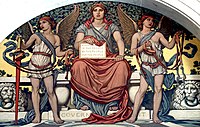
Photo from wikipedia
Abstract We compare the multipliers of expected and unexpected fiscal shocks. In doing so, we consider that the future path of fiscal policy is anticipated to some degree, and incorporate… Click to show full abstract
Abstract We compare the multipliers of expected and unexpected fiscal shocks. In doing so, we consider that the future path of fiscal policy is anticipated to some degree, and incorporate this characteristic into a news approach. We build a standard small open economy New-Keynesian DSGE model with a fully specified fiscal policy structure, and examine the Korean economy as an example of a small open emerging economy. We find that the present-value multiplier of the government consumption news shock in Korea is smaller than that of a corresponding surprise shock of the same magnitude, apart from the initial couple of years in the case of the output multiplier, and is consistently smaller in the cases of the consumption and investment multipliers. The present-value output multiplier of the government consumption news shock starts from about 0.72 and declines continuously to reach 0.16 after 40 years.
Journal Title: Economic Modelling
Year Published: 2020
Link to full text (if available)
Share on Social Media: Sign Up to like & get
recommendations!